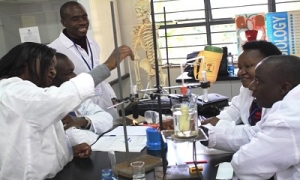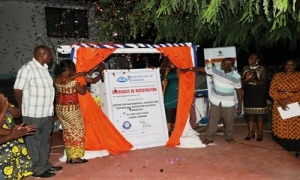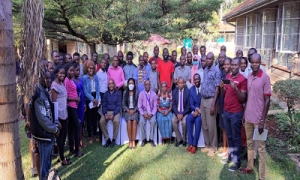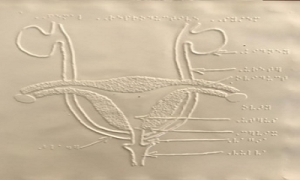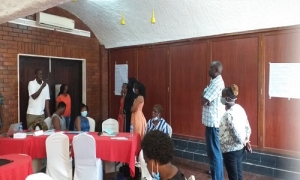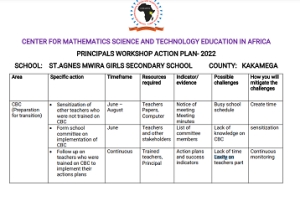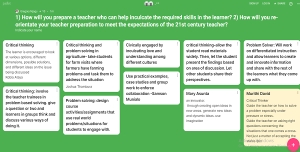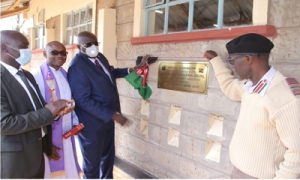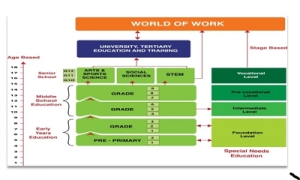Esther Nyambura
By Mr. John Makanda, and Ann Mumbi
Kenya is in the process of implementing the Competency Based Curriculum (CBC) and in the year 2023, learners will be transiting from Grade 6 to Grade 7 in Junior Secondary School.
In preparation for this transition, CEMASTEA organized training for secondary school principals drawn from the 47 counties. The theme of the training was ‘Enhancing pedagogical leadership for effective implementation of
Competency Based Curriculum and (SMASE) activities’ the Principals were taken through implementation of CBC in Junior Secondary Schools (JSS) and Senior Secondary Schools (SSS) with the expectation that they would describe the key features of Basic Education Curriculum Framework (BECF) for effective curriculum implementation, evaluate the schools’ readiness to implement the new learning areas under STEM and appreciate the role principals play in the implementation of CBC at JSS and SSS.
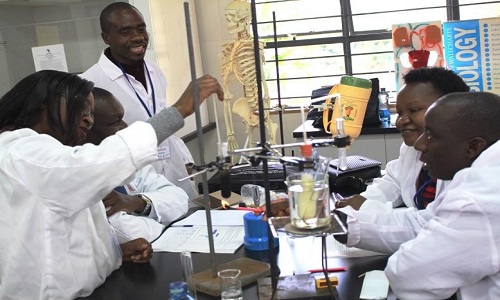
Trainees engaging in a science activity at CEMASTEA
For the Principals to explain pedagogical leadership in curriculum implementation, share ideas on how to provide pedagogical leadership in the implementation of SMASE activities at the school level, facilitate the application of knowledge and skills gained from SMASE activities to other subjects and appreciate their roles as pedagogical leaders for curriculum implementation, they were taken through the roles of the school principals in providing pedagogical leadership in the implementation of SMASE activities at the school level.
By Philip Maate
CEMASTEA is ISO 9001:2015 certified. It was first certified on ISO 9001:2008 in June 2014. It was thereafter recertified for ISO 9001:2015 in June 2017 and in January 2021. IOS 9001 is the international standard that specifies requirements for a quality management system (QMS). A QMS in simple terms refers to a collection of business processes or procedures which aim at ensuring that the quality of products or services offered meets or exceeds customer expectations. Certification is therefore evidence that an organization has a robust quality management system. CEMASTEA has therefore demonstrated ability to consistently provide products and services that meet customer and regulatory requirements.
CEMASTEA QMS is headed by the Management Representative (MR) and the ISO committee headed by the ISO chairmen. To ensure high quality standards, CEMASTEA conducts internal quality audits biannually in all its 19 processes. Examples of processes include Training, Finance, Top management, Human Resource, Supply Chain, among others. Quality assurance for the QMS is done by conducting internal audits using ISO: 9001:2015 Standard criteria. CEMASTEA has 49 ISO lead auditors and 17 auditors who take part in the internal audits. Surveillance QMS audits to CEMASTEA are conducted by Kenya Bureau of Standards (KEBS) which is the certifying body. All heads of sections are trained ISO auditors. They therefore understand the QMS and hence ensure that it is maintained at high standards.
The Centre ensures monitoring of quality through:
- Analysis of customer feedback and establishes customer satisfaction index;
- Evaluating teachers trainings conducted to establish teacher professional development quality index;
- Monitoring achievement of service charter to establish the extent of achievement on quarterly basis; and
- Monitoring performance of external service
Walking the road of QMS has provided immense benefits to CEMASTEA which include:
- Ease and systematic implementation of planned activities due to laid down procedures
- Customer focus where process owners and staff have had increased awareness in meeting customers’ needs
- Improved documentation that has resulted in ease of reporting during evaluation of Performance Contracting
- Ensuring continual improvement through implementation of customer feedback and customer satisfaction survey recommendations.
ISO 9001:2015 certification means that CEMASTEA is a public institution that leads in provision of continuous professional development of teachers in STEM education.
By: Mr. John Makanda, Ben Mwangi and Winfred Magu
In April, CEMASTEA, in partnership with Education Development Trust (EDT), the Teachers Service Commission (TSC) and the Ministry of Education (MOE), organised a four-day training on Quality Gender-Responsive Science, Technology, Engineering, and Mathematics (STEM) Education. Participants for the training included Heads of Department, Quality Assurance and Standards Officers (QASOs) and Curriculum Support Officers (CSOs) from Kilifi, Kwale, Marsabit, Mombasa, Nairobi, Samburu, Tana River and Turkana Counties. The training took place from 4th - 7th April 2022 in Christian Organizations Research and Advisory Trust of Africa (CORAT Africa), Africa, Nairobi and Diani Forest Lodge in Kwale. The training theme was ‘Towards developing a quality gender-responsive stem education through enhancing learner-centred teaching and learning practices. There were three thematic areas; STEM and Gender, STEM Pedagogy & Gender and Communities of practice.
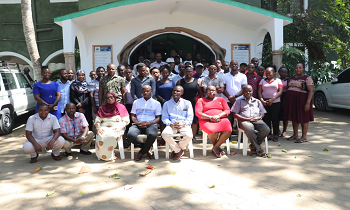
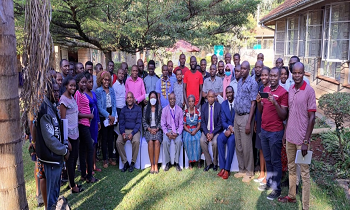
Group photos of participants, EDT staff , CEMASTEA trainers and Chief Guests, Mr. Bernard Okaka (Mombasa, above) and Mrs. Jacinta Akatsa (Nairobi, below)
During the training, participants learnt concepts of Gender-responsive pedagogy through plenary discussions, group discussions, scenarios, video clip observations, and textbook analysis. Key messages included that; teachers should encourage equal participation and involvement of boys and girls while taking into account their specific interests, learning styles and needs. Factors (individual, school, family and community) promote or hinder girls' participation in STEM learning. That it takes time to be proficient in developing and implementing lessons that have compelling gender considerations and that; gender-responsive pedagogy is part of ensuring inclusive learning environments where all learners feel respected and valued. Using models who have excelled in the field of STEM can encourage positive motivation and participation of girls in STEM. Teaching and learning materials are fundamental to the pedagogical process and can promote inclusive learning or reinforce systems of oppression, discrimination and inequality. Some important areas for inclusive gender-responsive concerns include; lesson planning, teaching and learning materials, language use in the classroom, gender-responsive activities, teaching approaches, classroom set-up and learning infrastructure.
In Kwale, the Chief Guest for the opening ceremony, TSC-County Director Mr Elias Gitonga, was represented by Mr Bernard Okaka, County ICT Officer. He elaborated on STEM subjects' critical role in achieving Sustainable Development Goals (SDGs) and developing a nation’s socioeconomic status. Mr Okaka affirmed that teachers’ roles are not only limited to imparting knowledge but competencies and skills in STEM subjects. He challenged the participants to continually improve themselves through training that provides the opportunity to grow professionally. He applauded the Education Development Trust and CEMASTEA for organizing the training. He equally lauded the teacher for attending the activity during the holidays.
Chief Guest for the opening ceremony in Nairobi was Ms Violet Munyasi, Principal Quality Assurance and Standard Officer, RDE Office. She explained that the role of the teacher in society could not be underestimated and informed participants that they were in a privileged position to learn and equip themselves with modern skills in teaching and learning. She encouraged the participants to take the initiative and provide an enabling environment for learners, especially in STEM and Competency-based Curriculum (CBC), to achieve positive learner outcomes. She reiterated that teachers should be the core components of the training and mentorship of learners in their schools.
Director CEMASTEA Mrs Jacinta Akatsa was the Chief Guest during the closing ceremony for the training in Nairobi, where she attended in person and Mombasa, where Ms Mary Sichangi represented her. She encouraged participants to change the narrative and preconceived notions about gender in STEM and the need to treat learners equally and build their self-esteem and confidence. She reminded teachers that learners are naturally curious and should aim to utilise the learner-centred pedagogy to tap into this. She encouraged the HODs to partner with school principals to establish and sustain communities of practice through school-based lesson study and to embrace a positive STEM culture by creating an inviting school climate. She lauded Ed Dev Trust for partnering with CEMASTEA to train the teachers and for the support that the Teachers Service Commission (TSC) and Ministry of Education (MoE) had accorded during the training
Senior officers from EDT participating in the training included Ms Margret Kamau from Nairobi and Mr Kaima Ruiga, Coordinator, Coast Region. They were happy with the training outputs and promised to continue supporting teachers, learners, and schools with relevant STEM resources.
By: Mungai Njoroge, PhD.
The Centre for Mathematics, Science and Technology Education in Africa (CEMASTEA) has established a Practitioner Journal of Mathematics and Science Teachers (PJM&ST). The PJM&ST is a publication innovation by the Research and Development department aimed at publishing reflections from practitioners to inform effective curriculum implementation and to enhance the learning of STEM concepts by learners at all levels of education.
Seven peer-reviewed articles are published in Volume 1, Issue 1 of PJM&ST for the FY 2021/2022. The articles address practice issues in the education and training sector pertinent to supporting the Social Pillar of Kenya Vision 2030 and Sustainable Development Goal No. Four aims to "ensure inclusive and equitable quality education and promote lifelong learning opportunities for all". The following is a synopsis of the articles in the order of appearance in the publication.
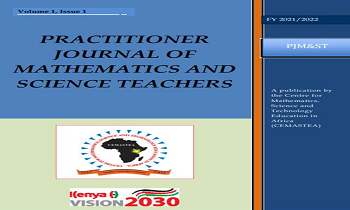
Cover page impression of Volume 1 Issue of the PJM&ST
- Expanding Instructional Spaces for Biology: The Role of "Talking Walls" article by Joseph Karanja Thuo emphasizes the role of the teacher in ensuring that students reap maximum benefits from 'Talking walls' in their schools.
- Learners' Unique Responses: Can they be used to promote learning? Rahab Chiira & Agnes Mwangi encourages teachers to draw on learners' unique responses and use them to promote learning.
- Modelling how to Elicit Learners' Ideas by Grace N. Orado calls on teachers to seek to understand learners' ideas, the thinking behind those ideas, and leverage learning based on those ideas.
- Demonstrating the critical angle and total internal reflection using a laser beam by John Kiplimo Chumo shares an experience of designing an Optical Model for use in teaching the content on a critical angle and total internal reflection in physics.
- The Magic of "Prerequisite Knowledge" in Meaningful Learner Engagement article by Hilliard Peter Kiwaza Righa reflects personal experiences depicting that prerequisite knowledge is vital if learners are to be fruitfully engaged in lesson activities.
- It can be done: Innovative Biology Practical Activities that Learners Can Identify with by Kennedy Kivonya is an appeal to teachers to come up with innovative activities and modify existing ones to make them learner-friendly for teaching Biology concepts.
- An Interpretation of Universal Design for Learning and its Application in the Competence-Based Curriculum by Mungai Njoroge shares an interpretation of UDL principles. It gives examples of how to actualize them to support the inclusion of all learners in the learning process.
The publication of Volume 1 Issue 1 of PJM&ST is available on the following:
- CEMASTEA's Website link: https://www.cemastea.ac.ke/index.php/tech/2014-11-18-13-33-16/publications
- Online Journal System link: cemastea.ac.ke
- CEMASTEA Content Repository Link: https://repository.cemastea.ac.ke/course/view.php?id=41
Plans are in progress to transition the publication of the PJM&ST to the Online Journal System (OJS) platform. Application for an International Standard Serial Number (ISSN) is in progress. Teachers and practitioners in STEM education are invited and encouraged to support PJM&ST by contributing articles in the upcoming Volumes and Issues.
By: Odhiambo John & Thuo Karanja
Research has shown that learners who are blind or visually impaired have the same range of cognitive abilities as other students. However, the predominant teaching methods heavily relying on vision are insufficient in meeting their needs. They cannot, therefore, appreciate anything around them because of their inability to see and synthesize whatever is within their vicinity. Moreover, blind and visually impaired learners' most reasonable accommodation and accessibility strategies involve adaptations to the physical environment, mobility and emotional aspects. This is more common for learners in mainstream education systems.
Blind and Visually-impaired learners have difficulties in accessing and applying science process skills since their vision is affected in one way or another. When engaged in practical work, it is seldom and mainly limited to elementary exercises that provide a little intellectual challenge with no opportunity for developing critical thinking and problem-solving skills.
Therefore, teachers must-have skills for planning lessons that demonstrate reasonable pedagogical accommodation of visually impaired learners. One way to enhance the potential of such learners to mitigate their challenges involves using Braille (for the total Blind) and large prints for the low vision learners. Braille enables learners to conceptualize what they cannot see; hence, tactile diagrams become necessary to help such learners develop their science processes to a level they could otherwise not reach. By touching or feeling the tactile diagrams with their fingers, blind or low visual learners are capable of learning concepts. Tactile diagrams are raised representations of graphical images adopted for the sense of touch. Tactile graphics can be pictures, maps, graphs and photographs (see attached photos)
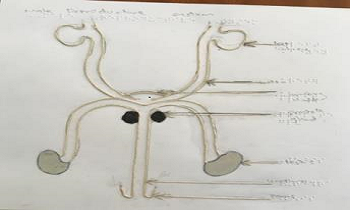
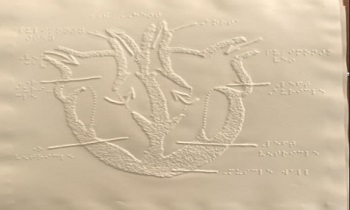

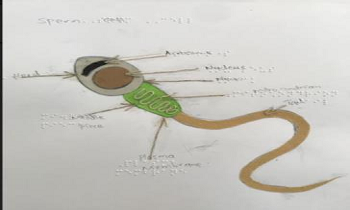
Sample tactile resources for teaching biology for visually impaired learners
The Disability Mainstreaming Committee (DMC) at CEMASTEA, working with the assistance of the National Council for Persons with Disability (NCPWD) and Kenya Institute for the Blind(KIB), have developed a policy aimed at mainstreaming, among other issues, a pedagogy that is responsive to the needs of Persons with Disability (PWDs). The idea is to increase relevant teaching and learning resources available to the Blind and visually impaired regarding content and forms of information media that suit their needs. The disability mainstreaming committee is piloting tactile teaching and learning resources for use with Blind and Visually impaired learners in Moi Girls High School, Nairobi. The activity involves mainstreaming disability-friendly pedagogies to assist eight students at the school. The Centre will provide the learners with graphic tactile modifications for biological structures, starting with reproduction in humans and flowering plants, the circulatory system (heart) and the nervous system.
CEMASTEA is making efforts to ensure the participation of learners with Special Needs in the competency Based Curriculum STEM pathway. As the country progresses with implementing CBC, there is a need to empower teachers to handle learners with various forms of disabilities. CEMASTEA and Kilimanjaro Trust are forming a partnership to develop more teaching and learning resources for special-needs learners.
By: Philip Maate
Mainstreaming programmes to prevent alcohol and drug abuse (ADA) and support those affected is an essential plan for government performance contracting. Successful mainstreaming is made possible through implementing certain activities such as training and sensitisation of staff. It is in this spirit that a group of nine supervisors and managers at CEMASTEA participated in a joint training (Kenya Rural Roads Authority (KERRA), Kenya Roads Board (KRB and CEMASTEA) conducted by the National Authority for the Campaign against Alcohol and Drug Abuse (NACADA). The training was held from 16th to 18th March 2022 at Mombasa Beach Hotel. The main objective of this training was to build the capacity of the managers and supervisors to understand and implement evidence-based interventions and help to prevent alcohol and drug use in the workplace.
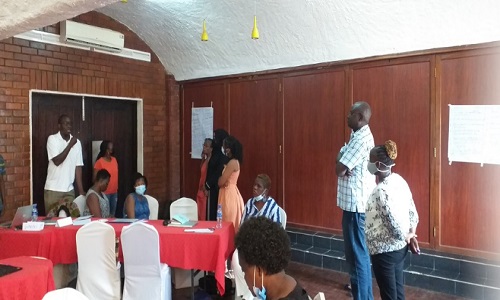
CEMASTEA staff and other training participants in a gallery walk
Some training contents included facts and statistics about commonly abused drugs, with alcohol coming on top as the most highly used drug in Kenya and worldwide. In another session, participants discussed and identified stressors at the workplace. Some stressors included ad hoc or unplanned activities, heavy workload and stagnation in one job group. It was noted that stressors are key triggers o of drug abuse. After the discussion, participants came up with remedies to the stressors. Two officers facilitated the training from NACADA, Susan Maua, manager of public education and policy and Miriam Medina, a senior trainer. Further facilitators led participants to identify components of substance use prevention programs and policies.
By: Dan Orero
CEMASTEA organised a two-day STEM Model School Principals workshop in Nakuru from June 10th – 11th. The workshop theme was ‘Enhancing Principals Pedagogical Leadership for Effective implementation of the STEM Pathway in the Competency-Based Curriculum. One hundred and one (101) Principals from the 103 STEM Model schools attended.
Some topics under consideration included understanding the STEM pathways in light of CBC, strategies for supporting STEM education programmed in their schools and the need for continued transformation into Centres of Excellence in STEM education. Strategies included the improvement of their schools’ STEM climate, making it more inviting, initiating programmes such as the maker’s spaces, and integrating education for sustainable development.
The Chief Guest during the opening ceremony was the Director General, State Department of Early learning & Basic Education, Ministry of Education, Mr Elyas Abdi. In his remarks, he challenged principals to ensure the learners got quality STEM education because of the Competency-Based Curriculum (CBC). He requested the school leaders to prepare for junior secondary intake, especially in STEM-related subjects. He encouraged principals to support their teachers continue to practice skills acquired during the STEM training by CEMASTEA. STEM model schools should stand out in every aspect such that neighbouring schools can emulate and learn from them.
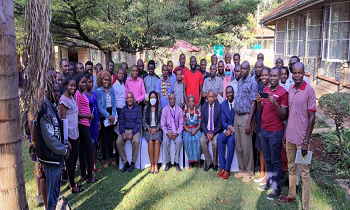
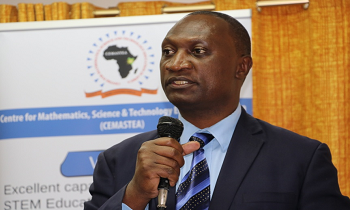
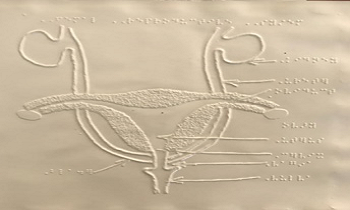
Chief Guest, Director General, State Department of Early learning & Basic Education, Ministry of Education, Mr. Elyas Abdi, Dr. John Aleke, Assistant Director Quality Assurance and Standards at the Teachers Service Commission and Mrs. Jacinta L. Akatsa, HSC, Director CEMASTEA while making her remarks during the workshop
The closing ceremony was presided over by Teachers Service Commission CEO Dr Nancy Macharia, represented by Dr John Aleke, Assistant Director of Quality Assurance and Standards. He thanked CEMASTEA for playing a pivotal role in initiating school principals in CBC and the STEM pathway. He urged the Principals to practice what they had been through and take the opportunity to learn from each other. He assured them of TSC’s commitment to continually support teachers and learners in promoting STEM-related activities. He challenged them to have their schools as centres of excellence in STEM education. He noted that the training equipped them with knowledge and skills to implement CBC at Junior Secondary, hence the need to offer exemplary pedagogical leadership to sensitize teachers and other stakeholders. “Make deliberate efforts to increase enrolment and achievement in STEM subjects”, he concluded.]
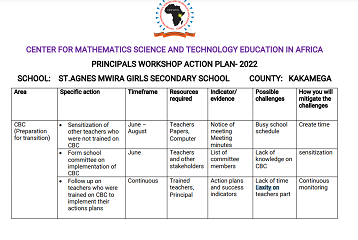
In her remarks, Director CEMASTEA, Mrs Jacinta Akatsa, encouraged the principals to invite STEM programmes that promoted the uptake and increased enrolment in STEM subjects. Noting that a conducive teaching and learning environment could lead to great results, she requested them to put in place structures that would ensure follow-ups and strengthen the transfer of knowledge and skills gained. The participating Principals developed an action plan detailed in various programmes they intended to do. These included preparation for CBC Junior secondary, lesson study, ICT integration and STEM projects and programmes.
By: Ben Mwangi
The introduction of the Competency-Based Curriculum (CBC) signalled the end of an era in Kenya's Education where ranking and cut-throat competition were at the heart of the sector.
It heralded the dawn of a system of equal learning opportunities for all, which would usher opportunities for learners to identify and exploit their talents and God-given abilities. One of the expectations for the successful implementation of the CBC lies in creating awareness and training key sector players with a vested interest in this matter.
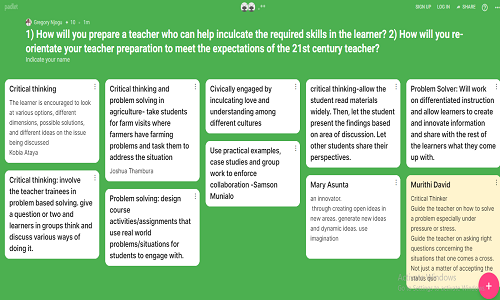
The training methodology involved the use of plenary presentations and discussions, group work and take-away assignments via resources such as the Padlet tool shown
In this spirit, CEMASTEA implemented customized training for lecturers from Meru University of Science & Technology’s (MUST) School of Education in topics aligned to CBC. The training was conducted virtually from 9th-12th May 2022.
The four days of training under the theme “Strengthen the capacity of teacher educators to equip teachers with the requisite skills and competencies relevant under the Competency-Based Curriculum” registered participation of 30 educators. The course covered four topics: Basic Education Curriculum Framework (BECF) and Competency-Based Assessment Framework (CBAF); Interpretation of Curriculum designs; ICT Integration in CBC, and Teacher Professional Development and Records.
The opening ceremony's Chief Guest was Professor Fatuma Chege, represented by Ms Ruth Mugambi. She informed participants that the State Department for the Implementation of Curriculum Reforms was mandated jointly with higher learning institutions and other stakeholders to prepare a rollout rationalization and migrate university education towards CBC aspirations. She noted that CBC is designed to offer a broad-based curriculum at the junior-school level that forms a foundation selection of pathways at Senior secondary and career-focused –schooling at the tertiary level. She was hopeful that the training would be a turning point for MUST to join other universities and stakeholders in the education sector in ensuring harmonious education reforms and migration to CBC. She told the university leadership that the Ministry of education was ready to provide any assistance as requested.
The closing ceremony was presided by the MUST Vice-Chancellor, who was represented by Dr Ibuathu Njati, Dean, School of Education. He acknowledged that while CBC is relatively new in Kenya, it has been fully operational in the United States of America since the 1960s. He indicated that CBC is the Philosophical umbrella that informs the core basics of teaching and notes that Africa has embraced this by focusing on student-learning outcomes. He reiterated that the job market has not been welcoming to university graduates; therefore, universities need to equip their graduates with 21st-century skills to counter this. He thanked training organizers for the effort, and exemplary work put in and wished for more engagements in the future.
The training was graced by the Principal Secretary of State Department For The Implementation Of Curriculum Reforms, Professor Fatuma Chege, represented by Ms Ruth Mugambi; University Council Chairperson, Professor Bosire Mwebi; Vice-Chancellor, Professor Romanus Odhiambo, represented by Acting Deputy Vice-Chancellor; Academic & Student Affairs, Professor Simon Thuranira; Director, Quality Assurance and Standards, Teachers Service Commission (TSC), Dr Reuben Nthamburi and Director, CEMASTEA, Mrs Jacinta L. Akatsa.
George Kiruja and Thuo Karanja
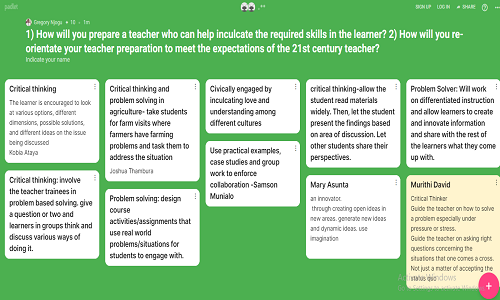 The three letters, CBC could be the most spoken of in the education sector in Kenya today. They evoke different reactions and emotions depending on whom one is conversing with. While to some, a Competency-Based Curriculum (CBC) is the greatest thing that could have ever happened in the education sector, to others, CBC is an unwelcome disruption and nuisance to the continuity of learning. In simple terms, the Kenyan Competency-based Curriculum (CBC) is a new education system designed to develop skills and knowledge (competencies) and apply those competencies to problem-solving in real-life situations/ enable the learner to cope with life challenges. The Vision for a Competency-based Curriculum is to have Engaged, Empowered, and Ethical Citizens, while the Mission is to Nurture Every Learner's Potential. CBC was launched by the Ministry of Education and rolled out in primary schools in 2017. The pioneers of CBC, who are currently in Grade 6, will transit to Junior Secondary School (JSS) Grade 7 in 2023.
The three letters, CBC could be the most spoken of in the education sector in Kenya today. They evoke different reactions and emotions depending on whom one is conversing with. While to some, a Competency-Based Curriculum (CBC) is the greatest thing that could have ever happened in the education sector, to others, CBC is an unwelcome disruption and nuisance to the continuity of learning. In simple terms, the Kenyan Competency-based Curriculum (CBC) is a new education system designed to develop skills and knowledge (competencies) and apply those competencies to problem-solving in real-life situations/ enable the learner to cope with life challenges. The Vision for a Competency-based Curriculum is to have Engaged, Empowered, and Ethical Citizens, while the Mission is to Nurture Every Learner's Potential. CBC was launched by the Ministry of Education and rolled out in primary schools in 2017. The pioneers of CBC, who are currently in Grade 6, will transit to Junior Secondary School (JSS) Grade 7 in 2023.
Significant and notable in the shift to CBC include the change in learning years from the 8-4-4 to 2-6-6-3. The levels are referenced as 'Grades' instead of the previous use of 'Standard' and 'Form'. The syllabus is referred to as 'Curriculum Designs'. Though not easy to understand and use in the initial stages, the designs seem to have details and clarity that make lesson implementation easy. In CBC Designs, topics and subtopics are referred to as 'strands and 'sub-strands', respectively. Lesson objectives are learning outcomes, and learner activities are learning experiences. There are a few new introductions, such as using a 'key inquiry question' signifying an orientation to teaching that focuses more on inquiry-based learning. Another change in CBC is lessons that focus on developing competencies and values. The seven core competencies include communication and collaboration, critical thinking and problem-solving, imagination and creativity, citizenship, learning to learn, self-efficacy, and digital literacy. Values of love, responsibility, respect, unity, peace, patriotism and integrity are to be integrated into lessons. While planning lessons, teachers are expected to mainstream at least one competency and one value.
Assessment is another essential aspect of the CBC curriculum. Emphasis is on the ability of every learner to demonstrate learning or competencies as opposed to the hitherto right or wrong approach to assessment. In CBC, learners are assessed along a continuum of personal capabilities, with feedback forming a more significant part of the assessment.
A learner can demonstrate learning by exceeding or performing below the assessor's expectations. Using rubrics in assessment enables a teacher to map out effective feedback related to the individual learner or a group of learners.
Other features of CBC include a greater emphasis on parental involvement in the business of their children's education. The design is such that learners collaborate with their parents to produce learning artefacts and portfolios via extended learning activities.
The success of CBC is hinged on the sensitization, awareness creation, and training of key stakeholders in the education subsector (parents, school leaders and teachers) on this transition's implications and its implementation dynamics. Parents are eager to know the role government expects them to play to facilitate meaningful learning experiences for their children at school. Teachers are keen to see the structure of CBC and especially the anticipated changes in the processes of planning and implementing instruction. School leaders are eager to understand how they must restructure school programmes and practices to accommodate CBC.
As a critical stakeholder in the capacity development ecosystem in the education subsector, CEMASTEA has reoriented its training programmes to focus on CBC. The training for STEM teachers and school leaders is heavy on content related to CBC. We have trained teachers on the structure of the CBC Framework and Curriculum Designs interpretation, basics of lesson planning and implementation of CBC lessons and Competency-Based Assessment (CBA). The success of CEMASTEA CBC training is hinged on the multisectoral approach in training material preparation and training. The contextualization of the training to focus on the specific needs of participants and the strategy of having input from the experts in CBCs' key outcome areas has resulted in top-rated practical training for CEMASTEA's CBC training programmes. CEMASTEA collaborates with institutions such as the Kenya Institute of Special Education (KISE), Kenya Institute of Curriculum Design and Kenya National Examination Council (KNEC).
By: Patrick Kogolla, Ag. Deputy Director Training CEMASTEA
Under the new 2–6–3–3–3 education system, commonly referred to as CBC, learners will spend a total of 17 years in school: two in pre-primary, six in primary school, three in junior secondary, three in senior secondary school and another three in university.
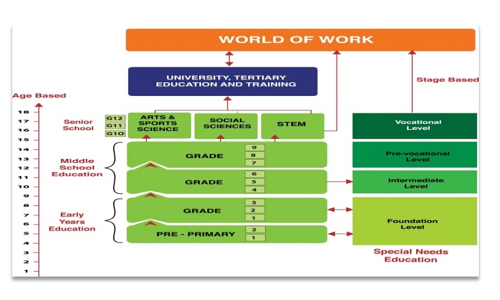
Learning progression in CBC
One of the critical milestones of implementing CBC is the transition of the learners currently in grade six to grade seven at Junior Secondary School (JSS). Junior Secondary school (JSS) is a stage of educational transition nested in most education systems between primary and senior secondary education. It is primarily for learners of Years 7, 8 and 9 and helps to ensure the bridge between primary and secondary school is safe, solid and consistent. In the Kenya context, grades 4, 5 & 6, together with grades 7, 8 & 9, form the middle school.
Junior Secondary Education will take three years; Grade 7, 8 and 9 for learners aged between 12 and 14 years. There will be 12 core/compulsory subjects in junior secondary. These are English, Kiswahili, Mathematics and Social Studies, Religious Education, Business Studies, Agriculture, life skills, Sports and Physical Education. New subjects include Integrated Science, Health Education and Pre-Technical and Pre-Career Education.
Learners with hearing impairment will undertake Kenyan Sign Language in place of English and Kiswahili. Integrated science, for example, will deal with basic concepts in science and some contents from physics, biology and chemistry. Pre-technical education prepares the learners for the world of work by instilling technical skills and knowledge needed to perform specific tasks. Pre-career Education seeks to prepare learners to choose their career paths after completing senior secondary in Grades 10, 11 and 12.
There will be a total of seven optional subjects in junior secondary. Learners will be allowed to choose a minimum of one and a maximum of two optional subjects. These subjects include Visual Arts, Performing Arts, Home Science and Computer Science, indigenous language and foreign languages, and learners' options to study the Kenya Sign Language. ICT will be cross-cutting in all subjects.
The Government has given resources to construct classes to accommodate the expected large numbers. Curriculum designs for grade seven are already out, and secondary school teachers are being trained to interpret and implement the designs. To join Junior Secondary Grade 6 learners in November 2022, sit the maiden national CBC assessment test- the Kenya Primary School Education Assessment (KPSEA). Approximately 1.24 million pioneer KPSEA candidates will join junior secondary schools in January 2023.
Junior secondary school will be closely watched as a transitional stage in CBC. While the die on CBC is cast and there is no going back, it will be necessary for those concerned to pick lessons and feedback to plough back and make the implementation smooth and successful as we advance. Lastly, it is essential to note that junior secondary school learners will mostly be adolescents. School leaders and teachers must focus on the child and as they implement their lessons. The focus should be geared to assist them in navigating self-efficacy and identifying their potential and worth. This way, the vision of CBC of ‘nurturing every learner’s potential’ will come alive.

